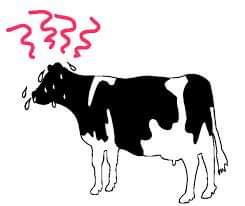Dr. Ashvini P. Bansod, Dr. Akash G. Kolaskar and Dr. Pooja R. Bahurupi
India is agricultural country and economics of country is mostly depend on agriculture. 70 % of rural households still depend primarily on agriculture for their occupation, with 82 % of farmers being small and marginal. In 2017-18, total food grain production was estimated at 275 million tonnes (MT). Indian agriculture sector interpretations for 18 % of India’s gross domestic product (GDP). Livestock health and production is important factor for agriculture. The livestock species play key role in economic and socio-cultural roles for the wellbeing of rural households, such as food supply, source of income, asset saving, source of employment and soil fertility. Sustainability in livestock production system is largely affected by climate change. Various disease conditions and stress affect the helath status and production of cattle. A compare to indigenous cattle, cross breed cattle are more sensitive to heat stress. An imbalance between metabolic heat production inside the animal body and its dissipation to the surroundings results to heat stress (HS) under high air temperature and humid climates. Due to heat stress, there is Weak and rapid Pulse rate, rapid and shallow heart rate, rectal temperature increases, animal unable to walk, weakness, Unusual salivation,it create reproductive problems, reduce growth rate and milk production too. The thermoneutral zone (TNZ) of dairy animals ranges from 16°C to 25°C, within which they maintained a physiological body temperature of 38.4-39.1°C. However, air temperatures above 20-25°C in temperate climate and 25-37°C in a tropical climate, it enhance heat gain beyond that lost from the body which induces heat stress.
For combating this heat stress and improving immunity, reproductive and other problems, some managments are make realted to their housing and diet. In housing, providing shade (natural or artificial) with proper ventilation is one of the simplest and cost-effective methods to minimize heat from solar radiations. Trees are used and natural shading materials providing shade to the animals combined with beneficial cooling as moisture evaporates from the leaves. Agri-nets with 20% perforation are also useful. Make barriers against hot wind using thatched wall or wet gunny cloth/ gunny bags. Artificial shades can be used to protect from the effects of solar radiation in absence of natural shade. For roofing system, white galvanized or aluminium roof is used. Sprinkle water in shed 2-3 times will cool the shed and help to prevent from stress. Provide cool water for drinking regularly. Feeding should be practiced during early morning, evening and night.
After housing management, Farmers should focus on nutritional stratergy. Nutritional modification during heat stress can prevent the animals from deficiencies. During heat stress, Dry matter intake decrease which reduce nutrient absorption. Rumen undegradable protein can reduces stress. DMI and milk production increased for cows fed with diets containing 14% versus 17 or 21% acid detergent fiber (ADF). High dietary fat content improved milk production efficiency and yield in the warm season . Low fibre content diet is prefer which related to acetate metabolism than propionate. Vitamine E is natural antioxidant which prevent lipid peroxidation due to peroxyl radicals. Vitamine A, C and E supplementation prevent oxidative damage and improve immune status which further improve feed efficiency and growth rate. Minerals supplementation like Pottasium and zinc in feed reduce heat stress. Na+ and K+ status of the body stayed normal during heat stress when supplemented with electrolytes could be due to better regulation of acid-base balance in the blood. Yeast also helpful in regulating ruminal ecosystem like decrease ammonia production and increase rumial microorganism population which improve digestibility of nutreints and production of volatile fatty acids. This nutritional therapy can protect the animals from heat stress and keep healthy.



